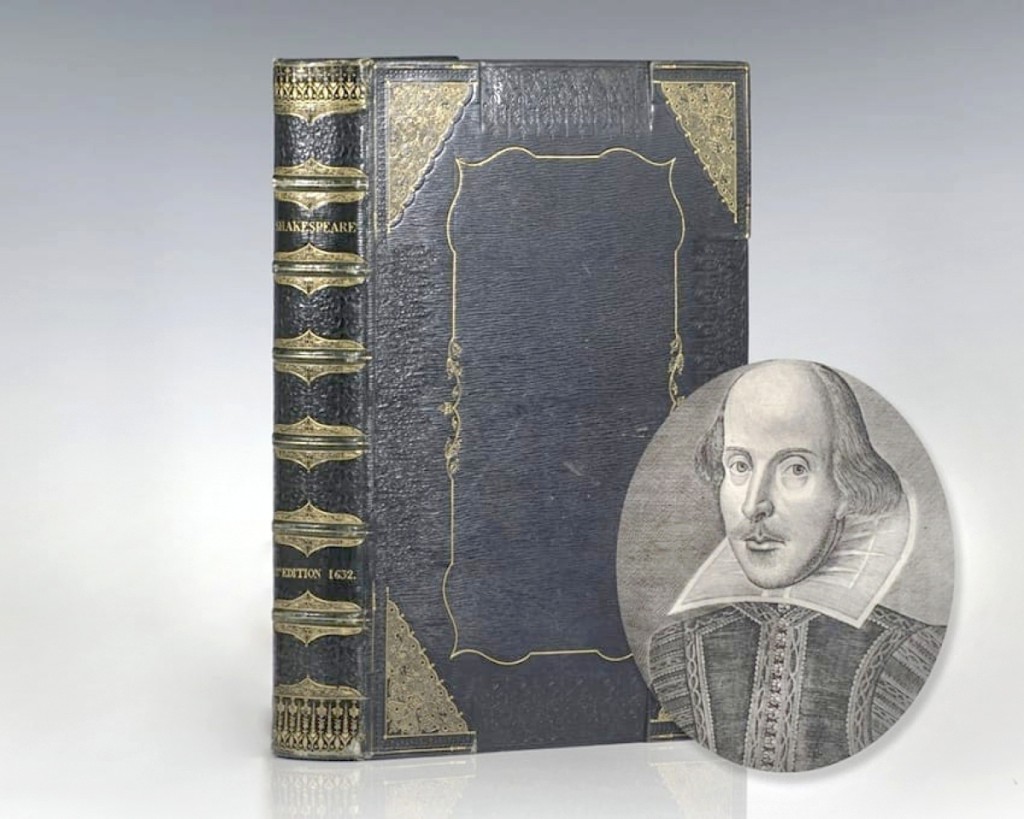
Published in 1616, after Shakespeare’s death, was a 1632 copy of the first issue of Shakespeare’s second folio, Mr William Shakespeare’s Comedies, Histories, and Tragedies. It was perhaps one of the rarest volumes at the show and was priced at $500,000. —Boston International Antiquarian Book Fair
Review and Onsite Photos by Rick Russack, Additional Photos Courtesy of Skinner, Inc.
BOSTON, MASS. – This was the week for book lovers. The Boston International Antiquarian Book Fair, November 15-17, brought 132 dealers – 36 of whom are from outside the United States – to Boston, and Marvin Getman’s Book, Print and Ephemera Show, November 16, added another 50 dealers. Skinner’s books and manuscripts sale was conducted in an online sale that ended November 17, offering more than 500 lots of books, manuscripts and maps. Buyers who wished to do so could spend upwards of $500,000 or as little as $10.
Show dealers showcased first editions, maps, photographs, autographs, illuminated books and manuscripts, prints, broadsides, ephemera, wood block prints, bookplates, early games and much more. Skinner offered maps, autographs, posters, first editions, photographs, Arabic manuscripts and illuminated books. To say that there was something for everyone would be an understatement. Attending the book fairs was not expensive. Other than the $25 charge for the Friday evening preview of the Boston International Antiquarian Book Fair, admission was free to all both Saturday and Sunday. The website for the Book, Print and Ephemera show offered discounted and free tickets along with subsidized parking, and the Skinner offerings were out there for everyone. Dealers at both shows said they made numerous sales to new customers and first-time buyers.
The Boston International Antiquarian Book Fair
This fair is sanctioned by the Antiquarian Booksellers’ Association of America and the International League of Antiquarian Booksellers. Many of the dealers are from Europe and several are from other states so that buyers are looking at material that they might not otherwise see. Rarities abound at this show and allow attendees the opportunity to see – and handle if they so wish – volumes that are normally behind glass in libraries and museums. Perhaps one of the rarest volumes at the show was a 1632 copy of the first issue of Shakespeare’s Second Folio, Mr William Shakespeare’s Comedies, Histories, and Tragedies. Published according to the true Originall Copies. After Shakespeare’s death in 1616, his plays were published in one volume, now referred to as the “First Folio,” at the expense of his fellow actors. The Second Folio was published a few years later. According to Mathew Raptis, Palm Beach, Fla., who priced the book at $500,000, “No more than 1,000 copies of the Second Folio were printed, and it is believed that fewer than 200 copies are still in existence today, many of which are incomplete or in poor condition.” Peter Harrington had a Fourth Folio, published in 1685, for which he was asking $240,000.
Both Raptis and James Gray, Princeton, Mass., had copies of the first edition of the 1611 King James bible. The title page reads The Holy Bible, : conteyning the Old Testament, and the New: newly translated out of the originall tongues: & with the former translations diligently compared and reuised, by His Maiesties speciall com[m]andement. Appointed to be read in churches. First editions can be positively identified due to a typographical error that was corrected in subsequent editions. Gray’s copy was priced at $230,000, and the Raptis copy was $140,000. Gray said that only 296 copies of this edition are known to exist and fewer than 50 complete copies exist. “Mine was missing only the last leaf; otherwise, it was complete, and that missing leaf was included in facsimile. It’s been said that it’s the only literary masterpiece ever to have been produced by a committee. More than 50 translators participated in producing the final text.” In thinking about this book, consider that it was printed nearly ten years before the Pilgrims landed at Plymouth Rock. Gray went on to say, “It was a good show for me. I sold two illuminated manuscripts that date back to the time before the printing press. They were in the $75,000 to $100,000 price range. You didn’t ask about the age of buyers, but I had a sale to an ‘old’ client. A 93-year-old man, who has bought from me before, asked me to put a book on hold for him. Gray’s descriptions are comprehensive, and he said, “I enjoy doing the research needed to fully understand the context of the books I’m offering and I think that clients appreciate that time and effort.”
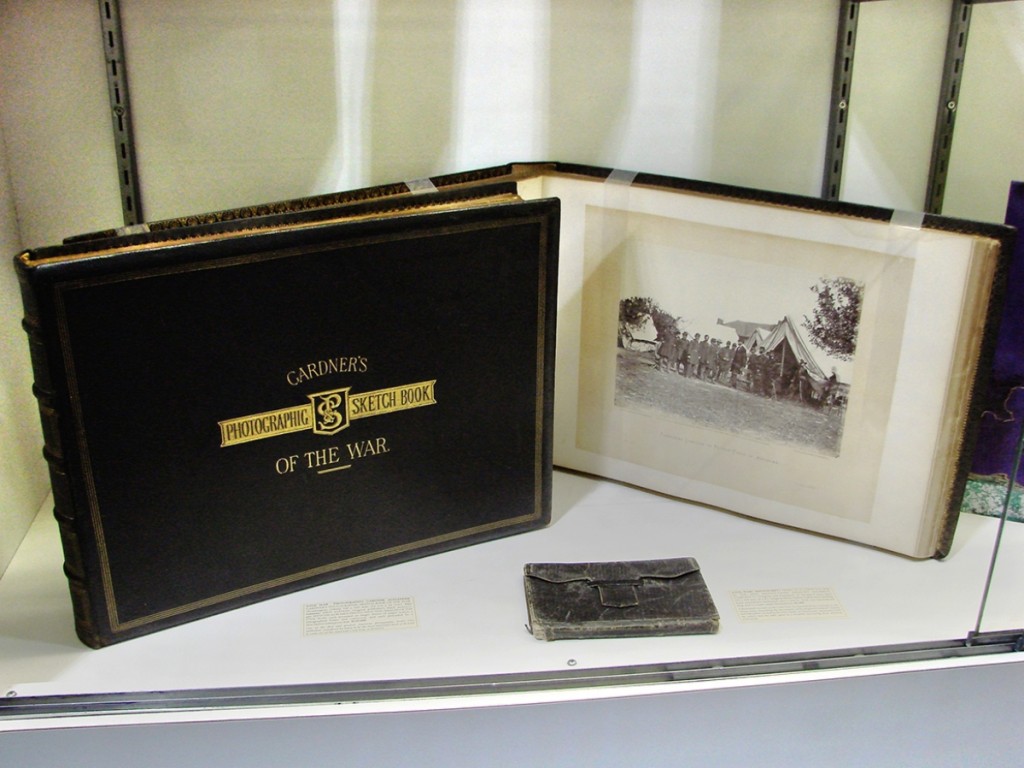
Arguably, one of the most important books to come out of the Civil War was Gardner’s Photographic Sketch Book of The War, published in 1866. In two volumes, it contains 100 large albumen photographs by Alexander Gardner. Each is preceded by a page of text, and each photo is mounted on a larger sheet of paper, each with a lithographed border. Phillip J. Pirages Fine Books and Manuscripts, McMinnville, Ore., priced the set at $125,000. —Boston International Antiquarian Book Fair
Other early bibles were offered by several dealers. Exhibitors had been advised prior to the show that the International Society of Bible Collector’s annual meeting was to be conducted in Boston and would coincide with the fair, so it was suggested they bring early bibles if they had any.
We’ve only space to list a few of the many rare and interesting items that were offered. British dealer Justin Croft offered the illustrated first edition of the 1784 book on experiments that resulted in the first successful flight of a hot-air dirigible, and he priced it $1,600. He also offered a set of five copper engravings used to illustrate the 1876 edition of Flaubert’s Madame Bovary and was asking $8,000. Heartwood Books and Art, Fort Lauderdale, Fla., had dozens of first editions of classic science fiction and mysteries. The first edition of Isaac Asimov’s I, Robot, of which only 5,000 were printed, was priced $2,200. The dealer had several of Robert Heinlein’s first editions; The Man Who Sold The Moon was priced $1,700, signed by the author; and Podkayne of Mars was $2,750. William Reese Company, New Haven, Conn., had an autograph receipt for the sale of six books, signed twice by Benedict Arnold, from the period of his life when he was a bookseller. In 1767, well before his traitorous activities, he had a shop in New Haven that sold cosmetics, rum, books and much more. The receipt was priced at $17,500. It should be noted that many of the dealers at this show produced informative, descriptive catalogs of the books they brought to the show and distributed them at no cost. Reese’s catalog description of the Benedict Arnold item was about one and a half pages. Reese also had a copy of an extremely rare 1815 large folding map of Ohio. Reese describes the history of the map and notes that the last copy to appear at auction, in 1968, was the Thomas Streeter copy, which sold at the time for $100. This copy was priced $75,000.
Peter Harrington, London, had a wide assortment of early works of exploration, including Sydney Parkinson’s Journal of the Voyage to the South Seas in His Majesty’s ship, the Endeavour. This 1784 edition recounted Captain James Cook’s voyage to Australia and was illustrated by 27 plates and included maps of Hawaii and New Zealand. The author was the first European artist to set foot in Australia. The book was priced at $30,000. He also had an inscribed first edition, in dust jacket, of William Faulkner’s 1932 Light in August, which was priced at $65,000, and a first edition of F. Scott Fitzgerald’s Tender is the Night, signed by the author, priced at $40,000. Jonkers Rare Books, also a British dealer, offered a near fine copy of the first edition of the first James Bond novel, Casino Royale, priced at $59,000, and a 1937 first edition of Agatha Christie’s Dumb Witness, featuring Hercule Poirot, priced at $35,000.
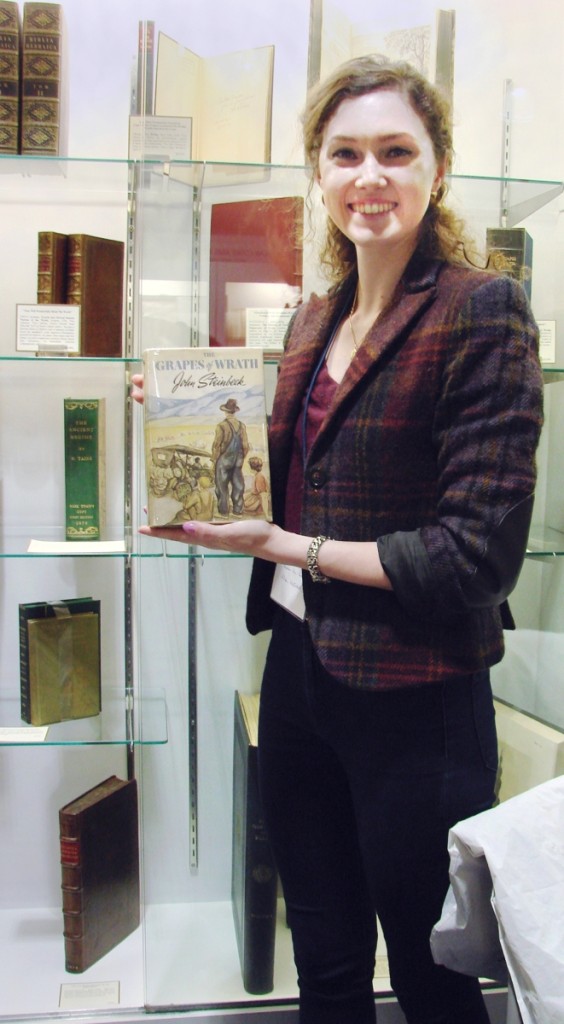
Twenty-eight-year-old Allison MacIntosh, with a degree in the classics, has worked for Bauman Rare Books, New York, for about three years. “I’m learning something new every day,” she said, holding up a first edition of John Steinbeck’s Grapes of Wrath priced at $29,500. —Boston
International Antiquarian Book Fair
Ken Gloss, Brattle Book Shop, Boston, was the show chairman. Both he and Nina Berger, the show’s media relations consultant, estimated that attendance at this year’s event was about 5,000. Both commented on the increase in women and younger buyers. A few days after the show, Gloss said, “I spent time talking with other exhibitors, and nearly all said that they did well enough that they will plan on exhibiting at next year’s show. I didn’t hear any of the dealers say they were unhappy, or that they had done poorly. From my experience, the unhappy guys are usually the loudest, and not hearing any complaints said to me that we got it right this year. And the British dealers benefited from the favorable exchange rate. We had six free programs for show attendees, three each on Saturday and Sunday. The talk on the illustrations of Kay Neielsen by Megan Melvin from Boston’s Museum of Fine Arts probably drew the largest crowd. You asked if any books sold for more than $100,000. The answer is yes; I know one early Canadian book sold for $110,000, but I really don’t think the dealer would want me to talk about it. Dozens of sales were made in the high five figures. And there was fun stuff. We sold a book on cats that had been written by Andy Warhol and was inscribed by Warhol to his mother, ‘From the son of Andy Warhol’s mother’ and it included his daytime and evening phone numbers. Warhol was a cat lover, and one time had as many as 25 cats. It was under $5,000.”
The Book, Print and Ephemera Show
This 50-dealer show is promoted as a satellite show to the larger international show and is in a facility four blocks away. It is scheduled to start at 8 am, allowing dealers from the other show to shop comfortably before that show opens at noon. And they do. The crowd was large and selling began within a few minutes of opening. This influx of early morning buyers provided exhibitors with the opportunity to show their stock to dealers they might not otherwise see – especially the 36 dealers from abroad, as well as the dealers from other parts of the United States and the collectors that the show attracts.
The selection of material was broad and the quality was high. There were booths full of children’s books, booths full of photographs, literary first editions, ephemera, historical material, maps, cookbooks and more. A special exhibit, mounted by collector Brian Chidester, gave attendees a good look at Beach Boys ephemera; album covers, photographs, concert posters and more. It traced the group’s popularity from their early recordings in the early 1960s and explained the “surfing” culture that the group capitalized on.
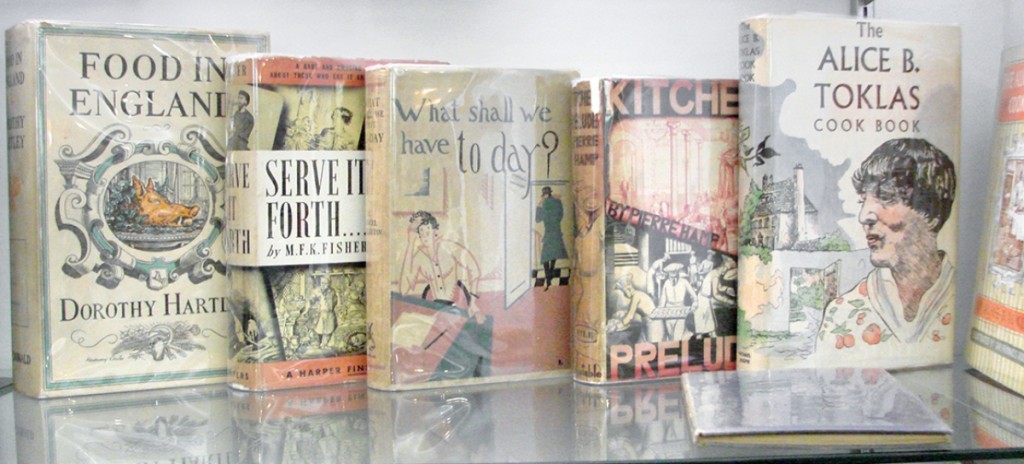
Johnnycake Books, Saugus, Conn., had a large selection of cookbooks.
—The Book, Print and Ephemera Show
After the show, Marvin Getman commented, “This was our best Boston attendance yet. The crowd was strongest in the morning and continued all day. Dealers were pleased with their sales, with some telling me it was their best Boston fair yet.” The morning after the show, Getman solicits comments from his exhibitors as to how the show went for them. Several commented on sales to dealers from the international show and the overall level of sales. Scott Brasseur, gallery bfa, said, “I had a very solid show. Of note, I added some new institutional contacts and my biggest sales ticket was written to a first-time attendee from California.” Kurt Sanftleben, Read ’em Again Books and Paper, said, ” We stayed busy all day. It was jammed on Saturday morning, and we even had two customers in our booth at closing. On Saturday morning, several booksellers who were exhibiting at the other fair remarked that the inventory on display was exceptional. I certainly agree with that; we bought a bunch of first-rate ephemera and manuscript Americana. We sold well, including a number of items in the $1,500 to $3,500 price range. We also recorded a dozen or so under-$100 sales to new collectors. Several of our sales were into five figures. Obviously, we’re very pleased.”
Skinner
Each year, to coincide with the International Book Fair, Skinner schedules a sale of good books. This year’s sale, online only, included more than 500 lots and grossed $572,183. There were 474 bidders. Topping the sale, bringing $28,290, was a 1776, Norwich, Conn., edition of Thomas Paine’s Common Sense; Addressed to the Inhabitants of America, one of the classic works of the American Revolutionary War period. It went far over the estimate. Appropriate to the season, an inscribed first edition of Clement Moore’s poems, including the first printing of “A Visit From St Nicholas,” sold for $3,998. Western photographs were popular with buyers and the second highest price of the sale was achieved for a lot of 276 stereo views by William Henry Jackson (1843-1942) and John Hillers (1843-1925), including 94 views from Hillers’ series, “Indians of The Colorbreed Valley,” which sold for $17,220. Other Western photos did well, with 11 large albumen photos by William Henry Jackson taken during the Hayden Expedition selling for $4,613, while ten large albumen photos of Navaho peoples by Charles Milton Bell (1848-1893) realized $7,995. Dozens of first editions of the classics of American literature were led by Walt Whitman’s Leaves of Grass, which finished at $12,300.
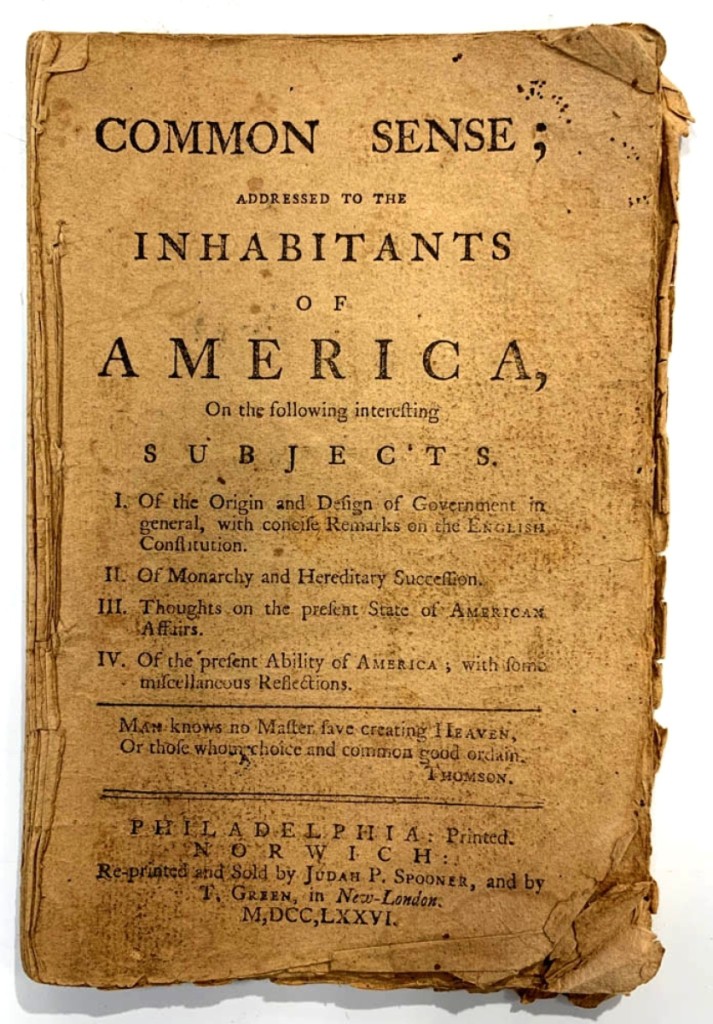
A 1776, Norwich, Conn., edition of Thomas Paine’s Common Sense; Addressed to the Inhabitants of America topped the sale finishing at $28,290, far over the estimate. —Skinner
After the sale, Devon Eastland, Skinner’s director of books and manuscripts, said, “The old favorites did well, and it was good to see some of the results we got on historical things like the Thomas Paine. That surprised me. I was also pleasantly surprised at the $6,150 we got for a 1704 huge, colorful Dominican manuscript on parchment missal with 139 numbered leaves. We were about 100 percent sold by dollar. “
Prices given include the buyer’s premium as stated by the auction house.
For additional information on the International Book Fair, http://bostonbookfair.com. For information on the Marvin Getman show, www.bookandpaperfairs.com/fairs/2016/1/23/boston-antiques-and-ephemera-fair or 781-862-4039. For more information on the Skinner sale, www.skinnerinc.com or 508-970-3000.

























